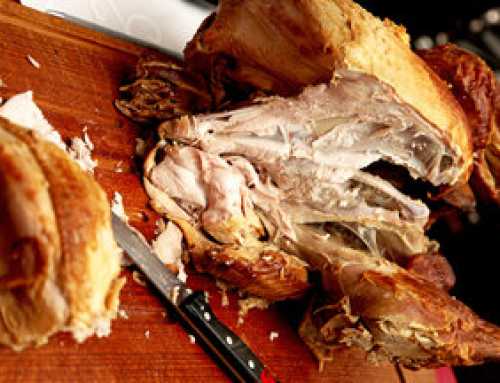Using herbs such as basil, dill, rosemary, thyme, cilantro and mint in your cooking is a great way to add a burst of feel good flavor to almost all your weeknight dinners. Readily available in farmer’s markets, grocery stores or even in your own herb garden, fresh herbs not only enhance the taste of your dishes, they add a sexy, playful dose of visual appeal to your nightly meal.
When you master the art of using herbs, whether fresh or dried, in your recipes, you’ll always have tantalizing dishes to serve your family at every meal and your guests at special occasions.
We all know we eat with our eyes-so if you can boost the yum quotient while making the food more appealing, I say bring on those delicious bundles of green beauties. There’s so much more to herbs than using them as a throw away garnish. Here are the secrets to using herbs to maxium your dinner’s flavor with minimal effort.
Nine Herbs for Cooking
Basil
Basil is similar to mint and adds a vibrant punch to your dishes. Sweet basil is most often used and is very popular in Mediterranean cooking. It works well in tomato based products like Italian sauces, but it’s also terrific in pesto.
It’s good in soups and stews, of course, but don’t forget you can experiment and add a little to your grilled or seared meats.
Other dishes it works great in include; Caprese salad, bruschetta, tomato soup, curry and marinara sauce.
Chives
Most people know chives work well in dips and when added to baked potatoes. But there is so much more you can do with chives. They are very similar to onions, but don’t usually have the heat, or bite, like onions. They also look great as a garnish, either chopped up or laid in small bunches across meats and other dishes.
Chives can be used in creamy chicken dishes, in a lobster bisque, a green goddess dressing, but it also works well in many cream cheese or sour cream based dishes. It gives added flavor to potato soup and many cooks enjoy adding it to baked goods, like crescent rolls and cheddar cheese biscuits.
Cilantro
Cilantro often goes by other names like coriander and Chinese parsley. One thing you can say about cilantro is that people either love it or hate it. Those who love it want to go overboard with using it. Those who hate it, don’t even want it in their foods and sauces at all.
To some people, cilantro has a lemony taste, which is why they love it in salsa and other dishes. However, other people have claimed it tastes like soap or something rotten. Studies of twins have concluded that liking or disliking cilantro may be associated to genetics.
Since it is one of those herbs that can be overpowering, and knowing that people either have a love or a hate relationship with it, be careful using it. You may want to experiment until you find the amount that gives added flavor, but allows the other flavors in the dish to come through.
Cilantro is most often used in Mexican foods like salsa, guacamole, pico de gallo and green sauce. You can generally look at the bowl of salsa on the table at a Mexican restaurant and see the cilantro leaves. It also makes Asian dishes sing.
Oregano
Oregano is widely known in Italian and Greek cuisine. It’s the most definitive flavor of pasta dishes like spaghetti and lasagna.
It can also over power other herbs, so you want to get a nice blend without going overboard. Oregano leaves enliven whatever they’re scattered over, be it a savory melon salad, or a piece of fish—and a little goes a long way. That said, when cooked, its flavor mellows so that it’s earthy but not aggressive.
It’srefreshing with watermelon and feta as well as with zucchini ribbons and chickpeas.
Mix it with olive oil, garlic, thyme, basil and onions and you’ll have a terrific marinade for beef, chicken, lamb or fish.
Dill
Dill is most often known for making pickles, but people have discovered that it adds a nice grassy, anise-like flavor to many dishes. In contrast to the leafy herb, dill seeds taste more like caraway seeds. Both the feathery green herb and its seed are commonly found in Eastern European and Nordic cuisines.
It’s most often used on grilled fish, but it can be added to soups, scrambled eggs and potatoes.
Other people like to add it to egg salad or tuna salad to add in some extra flavor for their sandwiches. It is a key ingredient, along with buttermilk, in giving homemade ranch dressing its unique flavor. Dill is a delicate herb that adds a nice finishing tough to your dishes.
When used in cooking, dill weed will lose flavor the longer it is cooked, so it should only be added at the last minute. On the other hand, dill seeds are hardy and will develop more aroma and flavor when heated.
Fresh dill can also be used as a beautiful garnish.
Thyme
Thyme offers a woodsy or earthy flavor to foods and is used in many Mediterranean dishes. It’s a part of the mint family and can be a robust addition to many recipes.
It’s good in soups and stews, beans, tomato dishes as well as in meat and potato dishes. Thyme is an herb that’s an ideal seasoning for poultry; it can be found in a poultry seasoning blends as well as recipes for stuffing.
It is most often used in pasta sauces because it blends well with oregano and other Italian and Mediterranean herbs. It is the main ingredient in the classic French herb combinations Boquet Garni and Herbes de Province.
As an aromatic herb it also adds a wonderful smell when added to your dishes.
Rosemary
Rosemary has a woodsy or citrus flavor and smells somewhat like pine needles. It is often used in Mediterranean dishes and infused with balsamic vinegar for drizzling over salads. In small amounts, it adds a huge punch to your dishes. Because both fresh and dried rosemary can have a tough texture, make sure to chop or crush it with a mortar and pestle before adding to recipes. You can add whole sprigs of rosemary to soups and stews just remove it, stems and all, prior to serving.
In cooking, rosemary is a great addition to a variety of dishes such as soups, casseroles, salads, and stews. Use it with chicken and other poultry, game, lamb, pork, steaks, and fish, especially oily fish. Add a bit of lemon to rosemary grilled fish or salmon and you’ll have a nice zesty flavor that bursts in your mouth.
This earthy herb also goes well with grains, mushrooms, onions, peas, potatoes, and spinach.
Mint
Mint offers a zing that is fresh and tasty. It is most popular paired with chocolate these days, but it is also good in teas. ll. Add it to your morning smoothies. It not only has a fresh taste, but it can leave your mouth feeling fresh and offers a great deal of digestive benefits too.
Add some to your grains, salads or pasta sauces for a fresh new taste.
Sage
Most people are familiar with sage during the holidays. Many cooks will not serve stuffing or dressing (if you’re from the south) without a good amount of sage in the dish. But don’t limit your use of sage to the holidays. It’s too good an herb to limit its use to special occassions.
Sage pairs well with any meat, especially poultry and is a wonderful addition to cornmeal breading for fried (think air fryer) fish.
The herb is also commonly used to create a flavorful butter sauce for delicate pastas
And need I remind you, parsley, sage, rosemary and thyme!
How and When to Use Fresh Herbs
If you grow your own herbs, you will always have an abundance of fresh herbs. Fresh are the best for getting the health benefits out of herbs, but if your plants grow really well, you will want to dry some for later use.
Many recipes call for the use of fresh herbs. If you can’t find fresh herbs in your area or don’t have your own herb garden, then using dried herbs is best. However, be sure to add small amounts at a time. Dried herbs can be more potent. The last thing you want to do is ruin a wonderful dish by adding too much of an overpowering herb.
Fresh herbs are often used at the end of the cooking cycle and added just a few minutes before time to serve. Since they are fresh, they will readily leach their flavor into the dish. Also, using fresh herbs adds visual appeal so you don’t want them to look overly soggy or turn a muddy color in some dishes. You want the look of freshness.
Dried herbs, on the other hand should be added earlier on so they have time to rehydrate and release their flavor.
Fresh herbs can be cut or chopped with a knife, and in some situations, you may want to use a mortar and pestle. You can also use a mortar and pestle to crush dried herbs so they start releasing their flavor and aroma. The leaves of some fresh herbs, like cilantro, can be removed from the stem and used whole.
How to Use Dried Herbs if You Don’t Have Fresh
Sometimes you just don’t have fresh herbs around, so you’ll want to substitute with dried herbs instead. A good rule of thumb is to use a third of the amount of dried herbs. For example, if a recipe calls for a tablespoon of fresh herb, you’ll want to use a teaspoon of dried herb.
As with any meal you cook, taste tests are highly recommended. Add a little dried herb and give it a taste test after a few minutes. Keep doing this until you reach the desired flavor.
With many dried herbs, you’ll want to crush them in the palm of your hand before adding them to your dishes, or use a mortar and pestle like mentioned above to release their oils and aroma.
![]()
If you’re looking to add some spark to ho hum recipes, look no further than your local farmer’s market, your own garden or your supermarket’s produce aisle. Herbs are plentiful, readily available, reasonably priced and are the secret ingredient to transforming many ordinary meals into enjoyable taste sensations.
Love to hear your secrets for using hebs in your favorite recipes. Please share your tips in the comments below. Thanks, smiles.

Sign Up For Our Newsletter and Grab This FREE Sanity Saving PDF
We won’t tell your mom, promise!






Leave A Comment